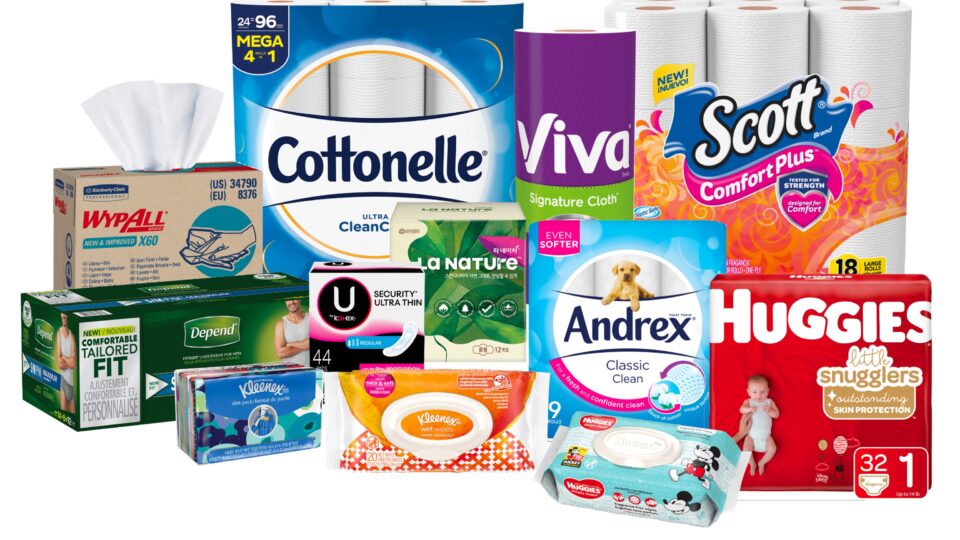Despite having been around for more than 150 years, Kimberly-Clark doesn’t have a whole lot of name recognition among consumers. But people definitely recognize Kimberly-Clark’s products, which include a host of household names like Huggies, Depends, Scott, Viva, Kotex and Cottonelle. In fact, some of its products are so ubiquitous that the brand has become an eponym for the whole category, as Kleenex has.
“I like to joke and say that we specialize in the areas of poo, periods, pee and snot,” said Andy Ford, Global Head of Product Design at Kimberly-Clark in an interview with Retail TouchPoints. “They’re not glamorous, but they are parts of everyday life.”
And as more and more of those customers’ lives move online, Kimberly-Clark, like many of its CPG counterparts, has begun steadily building out a digital presence for its brands — something that, not too long ago, was anathema for a company built on wholesale relationships. But now, consumers expect to be able to connect directly with the brands they see on their supermarket’s shelves. These days, the task of making that happen for Kimberly-Clark brands falls to Ford, who has led digital product strategy for CPG there for over five years.
To say it’s a big job might be an understatement. Not only does the company serve a wide customer set that reaches almost literally from the cradle to the grave, but unlike DTC brands, the goal of Kimberly-Clark’s digital efforts is often not to make a direct sale. Instead, the company’s brand websites and apps link together an intricate network of geo-located retail partners.
“We’re in 175 countries, and anywhere between one-quarter to one-third of the world’s population touches Kimberly-Clark products on a daily basis,” said Ford. “Our ultimate goal is to make it easy for you to [get the product you want], so a lot of what we do first and foremost is give you an indication as to where they’re located around the corner from you.”
But beyond simply steering consumers toward the right retailer, Kimberly-Clark’s digital products also serve as crucial resources for customers that help the company build relationships with the people who buy its brands. Among the ways they are doing this include:
- Using brand websites to get a deeper understanding of what consumers want from the company and its brands and then refining the digital experiences accordingly;
- Identifying and eliminating points of friction in the customer journey; and
- Developing innovative digital companion products that support and enhance the customer’s journey with Kimberly-Clark.
Refining the Purpose of Brand Websites
Without the benefit of the knowledge derived from making a direct sale (or not making it, in many cases), Ford and his team have turned to other tactics to get to know their consumers and understand what they want from their digital interactions with the company. In this regard, one of the most important tools in Ford’s arsenal is digital experience platform FullStory, which has worked with the company for going on four years now.
By tracking customer interactions (think clicks, scrolls, hovers, etc.) on websites and apps, FullStory helps brands get a real-world understanding of what consumers are seeing, doing and even feeling when on their digital platforms. Ford originally brought in FullStory to help his designers better understand how effective their work has been, but he said that the use cases quickly expanded out to the digital strategy and development teams as well. “Now, we’re starting to evolve to the point where we’re really understanding what journeys look like,” Ford said.
One of the biggest ways Ford has deployed FullStory has been to understand how and why customers are visiting his brand websites. “Generally speaking, our consumers come to us through the ‘side door,’” explained Ford, meaning that most visitors click through from other places online rather than going directly to, for example, Huggies.com.
“It’s one thing to have an article that we’ve co-authored with a medical expert to help mom understand the initial stages of childhood development,” Ford said. “But then, when they arrive [on our site], what do we do with them? Ideally, we’d like mom to go buy the box of Huggies diapers as well. FullStory has a great capability to help us understand how far users are scrolling on a screen, what they are clicking on, where the attention’s going and what that journey looks like from A to B to C.”
Moving from Understanding to Action
As Kimberly-Clark’s digital products have become more sophisticated and its work with FullStory has evolved, Ford said they have moved beyond just understanding their consumers’ behavior to building experiences that drive outcomes: “We’ve got all our platforms working in sync now and connecting with folks at a strategic level to understand where those opportunities exist,” he said.

For example, when the team set out to redesign the Huggies website, the design and content drew heavily from recent brand campaigns that had worked well in external environments like television — in particular the “We Got You Baby” campaign, which featured tongue-in-cheek messaging that welcomed babies to the world and “introduced” them to all the fun things they were going to get to experience.
However, in analyzing the insights from FullStory, Ford and his team realized that that messaging didn’t work for the consumers that were coming to the Huggies website, namely, parents. “[We saw very clear indications that that messaging] didn’t resonate with our consumers,” said Ford. “They were saying, ‘It sounds like you’re talking to my kid; talk to me.’ They wanted clear information on some very basic questions like how to prevent diaper rash.”
Through testing with various consumers, Ford and his team ended up shifting direction and adding elements to the site they hadn’t thought of. For example, the comments of one parent — who when faced with a “wall of diapers” at the grocery store, pulled up the Huggies website to compare different options — prompted the team to create a product comparison tool and place it front and center.
The team also realized that parents were visiting product detail pages not just for information on specific products but also to validate their choice by reading reviews, which shifted how the team designed those pages as well. Those small changes and additions, along with other improvements, led to a 50% to 75% increase in time spent on site.
As another example, Ford pointed to a moment when the team was trying to encourage visitors to a different brand website to provide personal details so that the company could stay in touch with them more effectively. They saw a huge drop-off in form completions from the First Name to the Last Name field, but they also noted that if someone completed the Last Name field, they were much more likely to complete the full form. So, they combined the First and Last Name fields into one Name field.
“Just being able to break things down to that microscopic level helps us as an organization to improve everywhere that we can,” said Ford.
Removing the ‘Grains of Sand’ that Create Friction
Indeed, many of these insights and changes can feel very small, but fixing them can have a huge impact. “Those small grains of sand are friction in the gears, and they genuinely do impact the customer experience,” said Lindsay Bayuk, Chief Marketing Officer of FullStory in an interview with Retail TouchPoints. “Retailers only have so much money to spend on marketing and advertising to drive people to their website. But once someone arrives at your website, that’s [your chance] to turn them into a customer or an advocate, so it’s a real opportunity to make your [marketing] spend more efficient.
“This is where some of the biggest gains can be made in efficiency and conversion,” Bayuk added. “Especially in today’s climate where spending at the top of the funnel off of your [own] site is expensive and to some extent risky, optimizing the experience on the property that you already own, with teams you’ve already paid, ensures efficiency with the resources that you already have.”
Ford illustrated this potential with another example: As the team was redesigning the Huggies site, which Ford said involved the biggest design team in his career, one of the items on the list was the baby registry. In the middle of the meeting, he “popped into” FullStory to check how the existing registry was performing and saw that of the 85,000 sessions that had been captured up to that point in the month, only 12 people went to the baby registry.
“In that particular case, it helped me to be much more judicious with our team’s time,” Ford said. “We do have fairly blown out baby registries in other parts of the world where it’s a bigger deal than it is here, and I could just see us going down the rabbit hole of trying to reinvent the baby registry. [That insight] allowed us to not invest time in things that aren’t needle movers and instead focus our attention on things that are.”
Finding Opportunities for Deeper Engagement

In addition to ensuring that brand websites deliver the information and engagement opportunities that customers are looking for, Kimberly-Clark also is beginning to build out a suite of digital tools that support customers of its various products, including a Kleenex pollen tracker, a Kotex period tracking app and even a Huggies poop scanner for new parents (it may sound out there, but parents will get the utility).
“There is not a tangible ROI component to most of these,” explained Ford. “They are developed in support of our brands, primarily to drive market share more than anything else. But today’s generation of consumers have grown up digitally native, so there is an expectation that there is a digital companion to accompany our physical products.”
For these newer digital products, which often are even further removed from direct sales, Ford continues to rely on FullStory to assess the effectiveness of what he and his team are building. For example, with the Kleenex “Pollen Pal” tracker, FullStory uncovered a number of “dead clicks,” where customers were attempting to click on an area of the tool that wasn’t clickable. This insight helped Ford and his team realize that users were looking for deeper insights into the types of pollen in their area and where it was coming from.
“It uncovered an opportunity for a deeper level of engagement that we didn’t even know existed,” said Ford. And in today’s tough marketing environment, deeper engagement with existing customers is priceless.













